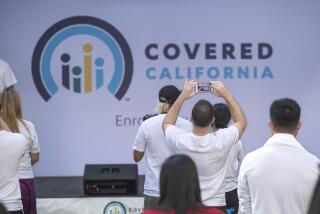Enrollment surge continues for Obamacare health coverage
WASHINGTON — More than 2.1 million Americans signed up for health insurance in the last three months of 2013 through new online marketplaces created by President Obama’s health law, as a December surge in enrollment helped the initiative recover from its disastrous launch.
But the enrollment numbers, released in a government report Monday, lag the Obama administration targets.
The data also suggest the marketplaces are still far more popular among older consumers, a trend that threatens to push up premiums unless more young, healthy Americans sign up for insurance.
A third of the new enrollees in October, November and December were between the ages of 55 and 64, according to the report from the Department of Health and Human Services. By contrast, only about a quarter were age 18 to 34, well below the 40% that administration officials are aiming for.
PHOTOS: The battle over Obamacare
Insurance industry officials have been closely watching the mix of customers, though a spokesman for America’s Health Insurance Plans, the industry’s Washington-based lobbying arm, said it was premature to draw conclusions about the mix since the enrollment period lasts until the end of March. “It is important to look at the enrollment picture over the whole six-month period,” spokesman Robert Zirkelbach said.
Administration officials Monday expressed optimism that the mix of customers would change. “We think more and more young people will sign up,” said Gary Cohen, who is overseeing the new marketplaces at the Centers for Medicare and Medicaid Services.
That prediction seems realistic to Larry Levitt, senior vice president at the nonprofit Kaiser Family Foundation, who studies insurance markets. “I would expect enrollment to surge in the second half, particularly in March,” he said.
The state-based marketplaces -- a centerpiece of the Affordable Care Act, also known as Obamacare -- were created so Americans who could not get coverage at work could select among plans that offer at least a basic set of benefits and do not turn away sick people.
The marketplaces opened Oct. 1. Americans making less than four times the federal poverty level, or about $94,000 for a family of four, qualify for government subsidies to offset the cost of their premiums.
To date, nearly 80% of new enrollees have qualified for financial assistance, according to the report.
Coverage started Jan. 1 for people who selected plans before Christmas. But Americans have until the end of March to choose a plan before they risk having to pay a fine for not having coverage.
Administration officials had hoped to get about 7 million people to sign up for plans in 2014, the first year of coverage under the law. It remains unclear if that number is within reach. Problems with the federally run marketplaces in 36 states and the HealthCare.gov web portal made it nearly impossible for many to shop for plans in October and November.
The problems appear to have been largely fixed by December. More than a million people signed up for plans in December through federally run marketplaces, seven times the number in October and November.
There were fewer problems in the 14 states that operate their own insurance marketplaces.
Enrollment in these states also surged in December, with 729,000 new enrollees in the month, three times the total in the previous two months.
With nearly 500,000 enrollees through Dec. 28, California, which runs its own marketplace, continues to top all states by a wide margin.
Florida, which relies on the federal government to run its marketplace, is now second in enrollments, with 158,000. New York, which operates its own marketplace, is third.
The administration has not said how many of the 2.1 million new enrollees have paid their first premiums, a key indicator of how many people will actually have health coverage.
Many insurers have allowed consumers to pay their first premiums in January to accommodate those who may have been confounded by the website problems.
Still more consumers may be considering their options. About 3 million people have not yet selected a plan but have filled out applications for coverage on the new insurance marketplaces since Oct. 1 and have been deemed eligible for a plan, according to the report.
The administration did not release any data about how many of the new enrollees were previously uninsured, making it impossible to calculate how much the health law is actually expanding coverage.
Many Americans who had bought their own health insurance plans because they did not get coverage at work received cancellation notices last year because their plans did not meet new standards in the healthcare law.
It remains unclear how many of those people have received new plans directly from their insurer, how many are shopping on the new marketplaces and how many are now uninsured.
Follow Politics Now on Twitter and Facebook
Twitter: @noamlevey
More to Read
Sign up for Essential California
The most important California stories and recommendations in your inbox every morning.
You may occasionally receive promotional content from the Los Angeles Times.











